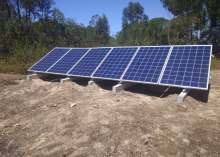With the world’s attention focused on fighting COVID-19, climate change – the other and far deadlier planetary crisis – is of course very much still with us.
There’s some welcome good news on this front then as, just before the Coronavirus stormed into our lives in the UK in March, the government performed a remarkable U-turn with its climate change policies.
In a move which took many by surprise, the government abruptly abandoned its opposition to subsidising onshore windfarms some five years after it ended its support for new projects, a policy which effectively stopped the UK’s booming onshore windfarm industry in its tracks.
This policy change means that onshore wind farms will now be able to compete for government subsidies alongside other renewable technologies such as offshore wind and solar.
The U-turn came after the government pledged to reduce UK carbon emissions to almost zero by 2050, a target which the government’s own climate advisers accepted could only be achieved by a massive tripling of onshore wind energy capacity within the next 15 years.
Not surprisingly climate change campaigners rushed to welcome the news. Alethea Warrington from the climate change campaign group Possible said:
“We can finally celebrate the UK’s cheapest new energy source – onshore wind – being brought in from the cold”
The UK’s wind energy industry was equally supportive of the move:
“This is a very significant announcement for our industry and for boosting renewable energy capacity in the UK,” said Luke Clark from Renewable UK, the UK’s renewable trade association.
So much for the good news. The bad news though is that whilst we can look forward to seeing new onshore wind farms being built across large parts of the UK, in reality there’s still an effective block on onshore wind farms in England.
It was back in 2015 that the then Prime Minister, David Cameron, caved in to pressure from Conservative MPs from the English shires who objected to onshore windfarms which they claimed were an eyesore and nothing more than an ugly blot on the landscape. Overnight this led to a blanket ban on onshore windfarms right across the whole of the UK.
However, because planning regulations are a devolved power, new onshore windfarm projects will find it far easier to get planning permission in Northern Ireland, Scotland and Wales.
“Since 2015, any planning application in England for a wind turbine can effectively be blocked by just by one or two objectors and this is the reason that no new turbines have been erected in England recently,” said Jeremy Thorpe from Sharenergy, a co-op which promotes community-owned renewable energy.
Bruce Davis from Abundance Investment, the online ethical investment platform agrees that planning is a major barrier to new onshore wind projects in England:
“We know that onshore wind is popular with the public, but we need to reform the planning process. As it stands it’s harder to develop a windfarm in England than it is to develop a high-rise tower block.”
But whilst new onshore windfarms may still struggle to get built in England, can we expect to see a wave of new community windfarms springing up across the rest of the UK?
John Malone from Energy4All which works with communities to develop renewable energy isn’t so sure:
“The recent changes will have little positive impact on community windfarm projects as the new support is for large windfarms greater than 5 megawatts. This precludes most community schemes which typically operate only two or three turbines”
Ultimately if we’re serious about tackling the climate crisis, then the planning system in England clearly needs to be urgently overhauled.
“We’ve barely scratched the surface of onshore wind energy in England,” said renewable energy consultant Gideon Richard.
“There’s an opportunity for onshore wind to play its part in England, how big a part, largely depends on the politics of it.”
The featured image (top) shows Mean Moor windfarm in South Cumbria which is owned by the local community.






